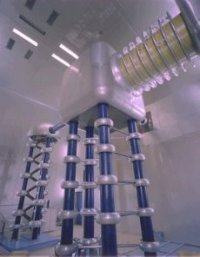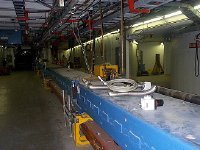Fermilabís Accelerators & Operators

Cockcroft-Walton, 750 KeV
LINAC, 400 MeV
Booster, 8 GeV
Main Injector, 120 GeV
Tevatron, One TeV
Switchyard/Fixed Target, will transport 120 GeV beam to Meson
Antiproton, 120 GeV protons focused on target to create 8 GeV Pbars
Recycler, 8 GeV

Preaccelerator
The particle beam begins with a Cockcroft-Walton style electrostatic Preaccelerator, pictured on the right. The protons come from a small bottle of hydrogen gas located in the larger enclosure. The source makes each proton pick up two electrons, giving the particle a negative charge.
The smaller structure is the Haefely voltage multiplier. It supplies the voltage that keeps the dome at a potential of -750 kV. The H- ions accelerate as they pass from their source toward the grounded Preaccelerator wall. The H- ions end up with energies up to 750 KeV. (1 eV equals one electron volt.)
750 keV Transport line & Chopper
The 750 KeV transport line guides the ions from the Preacc to the LINAC. The 750 KeV chopper, which consists of a pair of conducting plates that straddle the beam, determines the amount of beam that is allowed to pass from the source to the LINAC.
LINAC
The FNAL LINAC has two different sections. The first section consists of five cylindrical, electrically-resonant, water-cooled steel tanks clad inside with oxygen free, high conductivity copper, which are driven by five 5 MW power amplifiers. These Alvarez style drift-tubes accelerate the beam to approximately 200 MeV.
The second section has seven side-coupled cavity modules. These modules are constructed of single cells brazed together in a structure capable of high vacuum. The side-coupled cavities can operate at higher accelerating gradients than the drift-tubes, around 7.5 MV/m. This section has seven 12 MW, 805 MHz Klystron RF power supplies that drive the cavities and accelerate the beam to 400 MeV.
The beam is passed on from the LINAC to Booster where the extra electrons are stripped off and then from there transferred to the other accelerators.

Operators and Operations
Operators are responsible for running the accelerators. There are seven different machines an operator must control: the Preaccelerator, Antiproton Source, LINAC, Booster, Main Injector, Recycler, and Tevatron. There are also miles of switchyard and external beamlines that must be operated during the Fixed Target running periods. Fermilab has two physics modes of accelerator operation, collider and fixed target. When the next fixed target run begins, the accelerator will run simultaneously in both modes. In the past, there were years between collider and fixed target operation.
Collider operation involves accelerating protons in one direction and antiprotons in the other, colliding them at specific points around the ring. The collision points are designed to be inside the CDF, D0, C0, and E0 detectors located at strategic points on the ring. For Fixed Target operation the proton beam is accelerated around the ring and then extracted to service experiments. The beam is smashed into a stationary target made of various materials depending on the type of particle desired by the experiment.
There is much for an operator to know and learning how to operate the accelerators canít be mastered by reading a book. New operators best learn by doing the job, guided by experienced operators. They must complete a set of training modules on the following subjects: Proton Source, Main Injector, Tevatron, Anti Proton/Recycler, Switchyard/External Beamlines, Safety, and Controls. Each book has two sections: the Main Control Room OJT, which contains the procedures and tasks important to the Main Control Room (MCR), and the Walkaround OJT, which covers the devices and locations outside of the MCR.

Main Control Room
The accelerators, transport systems, and storage rings are all operated from this room, which has ~1900 square feet of space.
A crew consists of a Crew Chief and six Operators. In addition, system experts, studiers, and physicists use the consoles located in the MCR. Operators are on shift 24 hours a day, 7 days a week, 52 weeks a year, monitoring and controlling the accelerators.
A typical tuning console, picture at right, consists of a main screen, an alarms screen, 2 auxiliary screens, several comfort displays, the beam switch box, abort buttons, scopes, spectrum analyzers, CATV screens, and tuners.
There are several specialty consoles that monitor fire and utility alarms, radiation detectors, and the Safety System console that monitors enclosure interlock status. An operator can view approximately 150,000 devices from this station. These items may be things as simple as on or off status or as complex as a cryogenic system. An operator can manipulate approximately 50,000 devices from the MCR.
|